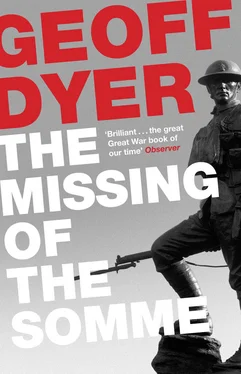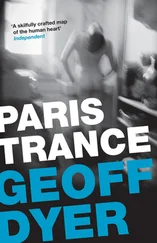Geoff Dyer - The Missing of the Somme
Здесь есть возможность читать онлайн «Geoff Dyer - The Missing of the Somme» весь текст электронной книги совершенно бесплатно (целиком полную версию без сокращений). В некоторых случаях можно слушать аудио, скачать через торрент в формате fb2 и присутствует краткое содержание. Год выпуска: 2012, Издательство: Canongate Books, Жанр: Биографии и Мемуары, Публицистика, Критика, на английском языке. Описание произведения, (предисловие) а так же отзывы посетителей доступны на портале библиотеки ЛибКат.
- Название:The Missing of the Somme
- Автор:
- Издательство:Canongate Books
- Жанр:
- Год:2012
- ISBN:нет данных
- Рейтинг книги:3 / 5. Голосов: 1
-
Избранное:Добавить в избранное
- Отзывы:
-
Ваша оценка:
- 60
- 1
- 2
- 3
- 4
- 5
The Missing of the Somme: краткое содержание, описание и аннотация
Предлагаем к чтению аннотацию, описание, краткое содержание или предисловие (зависит от того, что написал сам автор книги «The Missing of the Somme»). Если вы не нашли необходимую информацию о книге — напишите в комментариях, мы постараемся отыскать её.
The Missing of the Somme — читать онлайн бесплатно полную книгу (весь текст) целиком
Ниже представлен текст книги, разбитый по страницам. Система сохранения места последней прочитанной страницы, позволяет с удобством читать онлайн бесплатно книгу «The Missing of the Somme», без необходимости каждый раз заново искать на чём Вы остановились. Поставьте закладку, и сможете в любой момент перейти на страницу, на которой закончили чтение.
Интервал:
Закладка:
As I make my way towards it, the memorial at Thiepval seems almost ugly, its hulking immensity dominating the landscape for miles around.
At the car park on the edge of the site a sign states that this memorial stands on sacred ground. Visitors are asked not to bring dogs here, not to picnic, to try to preserve the beauty and tranquillity of the place.
There is no one else here. A wind moves through the jade-green trees. Green and black seem shades of each other. The grass is clipped razor-short, blazing bright green as though its colour is intensified by being so confined: potential inches of colour crammed into a centimetre. I can imagine nowhere more beautiful.
On 28 April 1917, Masefield wrote a letter describing the scene he witnessed here:
Corpses, rats, old tins, old weapons, rifles, bombs, legs, boots, skulls, cartridges, bits of wood & tin & iron & stone, parts of rotting bodies & festering heads lie scattered about. A more filthy evil hole you cannot imagine.
At the edge of the grass there is a long curving stone seat, where I sit and watch the British and French flags breezing perfectly from the summit of the huge monument. For once even the Union Jack does not look ugly.
The sun burns on the letters high up on the memorial: THE MISSING OF THE SOMME.
By contrast to the missing it commemorates, the Thiepval Memorial is palpably here, unmissable. 18Designed by Lutyens in High Empire style (if there is such a thing), there is no humility about it, no backing down, no regret.
Permanent, built to last, the monument has none of the vulnerability of the human body, none of its terrible propensity for harm. Its predominant relation is to the earth — not, as is the case with a cathedral, to the sky. A cathedral reaches up, defies gravity effortlessly, its effect is entirely vertiginous. And unlike a cathedral which is so graceful (full of grace) that, after a point, it disappears, becomes ethereal, the Thiepval Memorial, after a point, simply refuses to go any higher. It is stubborn, stoical. Like the deadlocked armies of the war, it stands its ground.
The contrast with a cathedral is telling in another, broader sense. In keeping with Lutyens’ general preference, the Memorial is stripped of Christian symbolism; there was, he felt, no need for it. For many men who survived, the Battle of the Somme (which, in memory, represents the core experience and expression of the Great War) put an end to the consoling power of religion. ‘From that moment,’ a soldier has said of the first day’s fighting, ‘all my religion died. All my teaching and beliefs in God had left me, never to return.’ In some ways, then, the Thiepval Memorial is a memorial if not to the death, then certainly to the superfluousness of God. Commemorated here is the faith of the ‘empty heaven’ evoked in a moving passage by Manning:
These apparently rude and brutal natures comforted, encouraged, and reconciled each other to fate, with a tenderness and tact which was more moving than anything in life. They had nothing; not even their own bodies which had become mere implements of warfare. They turned from the wreckage and misery of life to an empty heaven, and from an empty heaven to the silence of their own hearts. They had been brought to the last extremity of hope, and yet they put their hands on each other’s shoulders and said with a passionate conviction that it would be all right, though they had faith in nothing, but in themselves and in each other.
I cross the grass and walk up the shadow-mounted steps of the Memorial itself. A few wreaths have been left by the Great War Stone, their red petals glowing brightly against the pale stone. From here I can see that the monument is built on sixteen huge legs which come together in interlocking arches; also that it is made of brick. Concrete can be poured in a mass but bricks have to be placed individually just as, on each of the four sides of the sixteen legs, the names of the missing had to be carved on bands of white stone facing. (The design of the sixteen legs presumably originated in the need to create enough surface area to accommodate all the names in such a way — no more than five or six feet above head height — that they are easily readable.) Most names are here, arranged by regiments. Game W 27446, Game W 27448. There are several Dyers. High up, two plaques — French on one side, English on the other — explain that the names are recorded here of 73,077 men who lost their lives in the Battle of the Somme and to whom the fortunes of war denied the honour of proper burial.
I remember John Berger in a lecture suggesting that ours has been the century of departure, of migration, of exodus — of disappearance. ‘The century of people helplessly seeing others, who were close to them, disappear over the horizon.’ If this is so, then the Thiepval Memorial to the Missing casts a shadow into the future, a shadow which extends beyond the dead of the Holocaust, to the Gulag, to the ‘disappeared’ of South America and of Tiananmen.
There had been military disasters before the Battle of the Somme, but these — the Charge of the Light Brigade, for example — served only as indictments of individual strategy, not of the larger purpose of which they were a part. For the first time in history the Great War resulted in a sense of the utter waste and futility of war. If the twentieth century has drifted slowly towards an acute sense of waste as a moral and political issue, then the origins of the ecology of compassion (represented by the peace movement, most obviously) are to be found in the once-devastated landscape of the Somme.
That is why so much of the meaning of our century is concentrated here. Thiepval is not simply a site of commemoration but of prophecy, of birth as well as of death: a memorial to the future, to what the century had in store for those who were left, whom age would weary.
At the far side of the memorial there is a small cemetery. On the Cross of Sacrifice at the edge of the cemetery I read:
THAT THE WORLD MAY REMEMBER THE COMMON SACRIFICE
OF TWO AND A HALF MILLION DEAD HERE
HAVE BEEN LAID SIDE BY SIDE SOLDIERS OF FRANCE
AND OF THE BRITISH EMPIRE IN ETERNAL COMRADESHIP.
The cemetery is divided in two halves: French crosses on one side, English headstones on the other. A place where time and silence have stood their ground. In the distance, wheat fields and low hedges, trees. I walk along rows of crosses on each of which is written the single word: inconnu. Row after row. On the English side there are the pale headstones:
A SOLDIER
OF THE GREAT WAR
KNOWN UNTO GOD
In front of each grave there are flowers: flame-bursts of yellow, pink, red, orange. Apart from roses I recognize none of the flowers; the rest remain unknown, unnamed.
The only sound is of humming bees, of light passing through trees, striking the grass. Gradually I become aware that the air is alive with butterflies. The flowers are thick with the white blur of wings, the rust and black camouflage of Red Admirals, silent as ghosts. I remember the names of only a few butterflies but I know that the Greek word psyche means both ‘soul’ and ‘butterfly’. And as I sit and watch, I know also that what I am seeing are the souls of the nameless dead who lie here, fluttering through the perfect air.
It is early evening by the time I make my way to Beaumont-Hamel. I walk along a footpath to a small cemetery on the top of a low hill. From the cemetery gate I can see the crosses of four other small cemeteries.
The headstones are arranged in three lines, facing east. It is a perfect spot, without even the drone of cars to disturb it. The light is softening, stretching out over the fields. Soft and sharp, gentle and bright. I take out the register of graves. Cemetery Redan Ridge Number One: 154 soldiers lie here, 73 unidentified. As I look through the book, the sun makes the pages glow the same colour as the Great War Stone.
Читать дальшеИнтервал:
Закладка:
Похожие книги на «The Missing of the Somme»
Представляем Вашему вниманию похожие книги на «The Missing of the Somme» списком для выбора. Мы отобрали схожую по названию и смыслу литературу в надежде предоставить читателям больше вариантов отыскать новые, интересные, ещё непрочитанные произведения.
Обсуждение, отзывы о книге «The Missing of the Somme» и просто собственные мнения читателей. Оставьте ваши комментарии, напишите, что Вы думаете о произведении, его смысле или главных героях. Укажите что конкретно понравилось, а что нет, и почему Вы так считаете.












